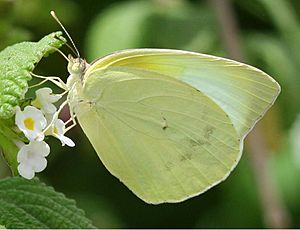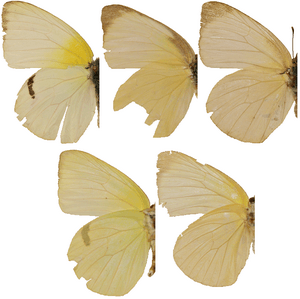Lyside sulphur facts for kids
Quick facts for kids Lyside Sulphur |
|
|---|---|
 |
|
| Scientific classification | |
| Kingdom: | |
| Phylum: | |
| Class: | |
| Order: | |
| Family: | |
| Subfamily: |
Coliadinae
|
| Genus: | |
| Species: |
K. lyside
|
| Binomial name | |
| Kricogonia lyside (Godart, 1819)
|
|
The Lyside Sulphur is a beautiful butterfly found in North America and South America. It's also called the Guayacan Sulphur. This butterfly belongs to the Pieridae family.
During times of heavy rain, like monsoon seasons, you might see many Lyside Sulphur butterflies flying together. They often travel in large groups called migrations. These migrations are common in Texas. They happen less often in the southwestern United States. Sometimes, these butterflies also live in southern Florida.
Contents
What the Lyside Sulphur Looks Like
The Lyside Sulphur butterfly can look a bit different from one butterfly to another. The top side of its wings is usually a pale yellow color. It often has a black bar along the top edge of its hind wing (the back wing). There's usually a bright yellow patch near the part of the fore wing (the front wing) that connects to its body.
Some butterflies might also have black borders along the top edges of their front wings. The underside of their wings can be different colors. They might be greenish, bright yellow, or even almost white. If a butterfly is greener, it will have a whitish vein in the middle of its hind wing. The front wing will still have that bright yellow patch near the body. These butterflies have a wingspan of about 1.5 to 2.38 inches (3.8 to 6 cm).
Butterflies That Look Similar
There are other butterflies that look a bit like the Lyside Sulphur. These include Queen Alexandra's Sulphur (Colias alexandra), the Cloudless Sulphur (Phoebis sennae), and the Statira Sulphur (Phoebis statira).
- Queen Alexandra's Sulphur: This butterfly has more yellow on the underside of its front wing. It also has a whitish spot in the middle of its hind wing.
- Cloudless Sulphur: This butterfly is bigger than the Lyside Sulphur. It is also much more yellow.
- Statira Sulphur: The top side of this butterfly's wings is more yellowish. The underside of its wings is pale greenish to white. Female Statira Sulphur butterflies have light pinkish marks.
When They Fly
You can see the Lyside Sulphur butterfly almost all year long in southern Texas. In Arizona, they are usually seen from early July to mid-November. In Florida, people have reported seeing them at different times from July to October.
Where They Live
The Lyside Sulphur butterfly likes to live in open areas. These areas are often subtropical scrub habitats. This means they are warm places with low-growing plants and bushes.
Lyside Sulphur Life Cycle
The caterpillar of the Lyside Sulphur can look different too. It might be green or a darker blackish-green. Some caterpillars have stripes, while others do not. If they have stripes, they usually run along the top and sides of their bodies.
This caterpillar is special because it's the only one known to eat the Guaiacum sanctum plant. The chrysalis (which is like a cocoon for butterflies) is a bluish-green color. The Lyside Sulphur can grow from an egg to a full-grown adult butterfly very quickly, sometimes in as little as 13 days! In southern Texas, they can have three or more groups of babies (called broods) each year.
What They Eat (Host Plants)
The Lyside Sulphur caterpillar eats specific plants. These plants are called host plants. Here are the plants that the Lyside Sulphur caterpillar eats:
- Guaiacum angustifolium - also known as Texas lignum-vitae
- Guaiacum sanctum - also known as Lignum vitae
See also
In Spanish: Mariposa del guayacán para niños


